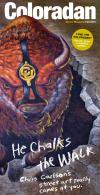 In 2018, Denver attorney Jordan Lipp (Econ, PolSci’00) and his wife Heather wrote Is There Apple Juice in My Wine?: Thirty-Eight Laws that Affect the Wine You Drink, detailing some of the odd, unique and unknown facts about wine.
In 2018, Denver attorney Jordan Lipp (Econ, PolSci’00) and his wife Heather wrote Is There Apple Juice in My Wine?: Thirty-Eight Laws that Affect the Wine You Drink, detailing some of the odd, unique and unknown facts about wine.
Why did you write about wine laws?
Several years ago, while wine tasting in the Sta. Rita Hills [in Santa Barbara], we were looking at the alcohol by volume on the back of a wine bottle, and the wine pourer told us we shouldn’t bother, as the number was more or less made up. We didn’t believe him. In response we told him we had learned in our sommelier class that wineries could put fermented apple juice in their wine. He didn’t believe us.
The next morning, as my wife and I were discussing these two stories, we thought, I’m a lawyer so I could look it up to see what is true and what is not. We came up with a list that morning of 20 or so wine “facts” we wanted to find out if they were true or not. Those 20 items from that morning of brainstorming ultimately became 20 of the 37 chapters of the book.
Where did you get your information for the book?
Fortunately as a lawyer, it was quite easy to do the legal research to look up what are the actual laws governing wine making, wine sales and wine consumption.
As many of these laws are so ridiculous that we’d have trouble believing that they were true had I not done the research myself, we made sure to footnote virtually every statement in the book so readers can easily verify every detail for themselves.
What’s the most absurd law you discovered?
It’s easy to start in our home state. By Colorado law, although not enforced, bars must serve sandwiches (as opposed to just serving pizza or burritos) if they want to serve alcohol. Perhaps the funniest law we found while researching the book is this: South Carolina has a law that wine cannot get you drunk.
Do some wines actually contain apple juice?
Yes, some contain apple juice, or to be more technically correct, fermented apple juice. If the wine label on the bottle lists either a state or smaller location from which the wine came (e.g., Oregon, Napa Valley, etc.), or if it lists the varietal (e.g., Cabernet Sauvignon, Chardonnay, etc.) you do not need to worry. But, if you look at your local liquor store, you’ll probably notice some cheap wine bottles or wine cans that do not have either a location or a varietal listed on the container, and it says in small print: “With Natural Flavors.” For those wines, we hope you like apple juice, because odds are that is what you are drinking.
Why is the U.S. drinking age higher than most of the world?
Our country went through a strong neo-Prohibitionist movement in the 1980s Reagan-era. In 1984, the federal government — under the pretense of keeping teenagers from driving from one state to another to buy alcohol — tied highway funding for states with the obligation for states to raise their drinking ages to 21 years old.
What wine fact do you like to share most?
When discussing wine tasting, one of our favorite facts is that it is hard to distinguish a red wine from a white wine when you’re drinking it in a black glass. When discussing what we learned from writing the book, we love to point out that under certain conditions, wineries are legally allowed to water down their wine up to 35 percent (That’s more than a glass of wine per bottle that can legally just be water.).

What should people do first when looking to buy a decent bottle of wine?
Our first rule of choosing a wine is to choose a bottle of wine that won’t give us a (chemically induced) headache the next morning. That can be tricky as there are no ingredient labels on wine, so you cannot tell what additives are in any particular wine bottle. As my wife and I have had so many different wines, we have a good sense of which producers we can trust and which ones we cannot.
If you don’t know the producers, here’s perhaps the easiest trick, though it only works for Italian wines: We have never had a headache from drinking Italian DOCG or DOC wine, which is the Italian government’s stamp of approval for certain wines. If we see the DOCG/DOC stamp on an Italian wine (usually placed on the neck of the bottle), we know we’re drinking a wine we can trust.
Your favorite glass of wine and food pairing?
Not to be contrarian, but I’m skeptical of wine and food pairings. I love the wines I love. And, I love the foods I love. If I have them together, I try to keep them from conflicting too much, but my goal is to always choose my wines based upon my mood and what wines I love, not what I am eating.
From a science perspective, Cornell University flavor chemist Professor Terry Acree had a great quote about wine and food pairing. Based upon years of research, he explained that wine and food pairing is: “completely contextual, and almost entirely individual.” From my lay experience, I could not agree more. I love Vin Santo and Sauternes, and would happily have either of them with a steak – which is something that would leave many wine lovers and sommeliers simply aghast.
That said, if I could have anything tonight, it would probably be a bottle of wine from the left bank of Bordeaux, France from the 2009 vintage (perhaps a Chateau Lagrange or a Chateau Kirwan) paired with Mimolette and aged Gouda cheeses and crackers.
Who would you love to share a bottle of wine with?
My wife and I have read that astrophysicist Neil DeGrasse Tyson is a wine connoisseur. We wrote a blog on trying to make wine understandable to everyone in the same way he makes physics understandable. We would love to have a bottle (or two) of wine with him.
Anything else we should know about you, your book or your career?
The wine book was my third book. My first book was on my other major passion – skiing. While a student at CU Boulder, I was a volunteer ski patroller at the old Berthoud Pass Ski Area, and after the ski area closed I wrote the backcountry skiing guidebook to the region: Backcountry Skiing Berthoud Pass. My second book was a legal treatise applicable to my day-to-day job: Product Liability Law & Procedure in Colorado.
Note: A condensed version of this Q&A appeared in the Fall 2019 issue of the print Coloradan.
Photo courtesy Jordan Lipp/@iStock/eli_asenova (wine glass)






